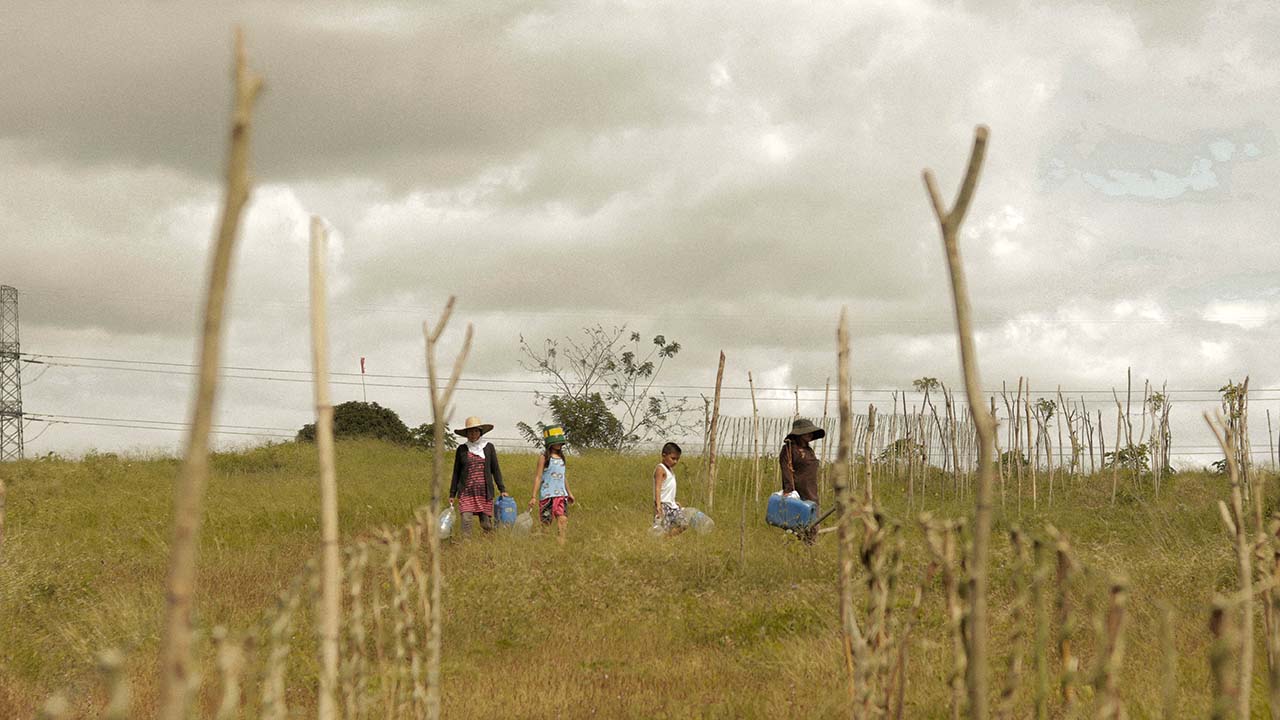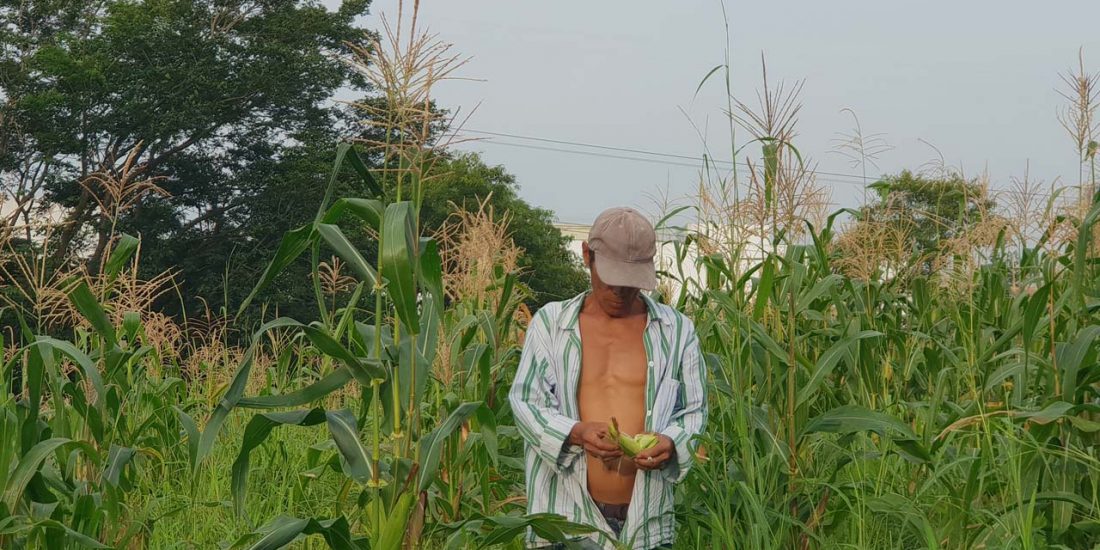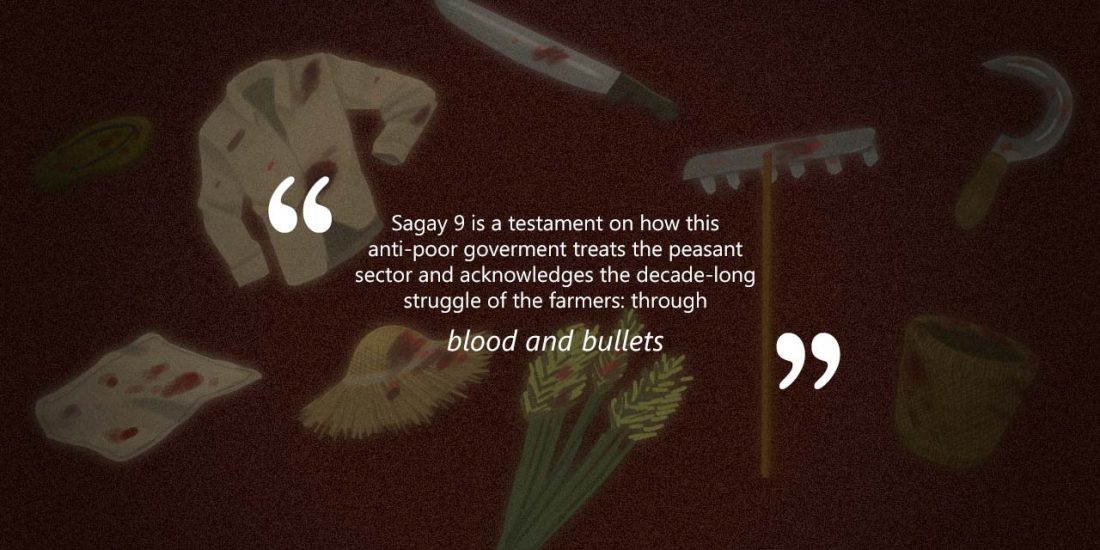Pagtawid
I brought my bag and packed a shirt. I was bound to write about the Kapdula farmers, but the immersion shaped the way I thought about agriculture. It explored my deepest and most critical of thoughts, and challenged myself on how this integration is the beginning of a new fight.
Kapdula
The grass-filled valley engulfed my expectations as I gazed upon their camp from afar. The way to go was downhill, up again, through rivers, and on stepping stones. Across the roaming highway where cars were rushing downtown south, I rested my feet and body from walking an extra mile to meet our guide.
I could smell nilagang mais nearby and was tempted to eat some before I began my trek. It was almost noon. The sun rays traced my skin and its heat parched my body down to its last sweat. The brisk wind was gusting, not a help at all—it was just enough to cool down my senses and calm my pores. the tall grasses leaning to the direction of the breeze were more carefree than I was; more vulnerable, yet much sturdier.
It was the element of discovery that pushed me further as I descended the steep path of the hillside. The past amount of rainfalls had ruined the carved steps, making it strenuous to keep balance and focus; one mistake and you could foolishly inflict yourself.
We crossed a small river and this time after, we had to climb up. I took off my shoes and took a step on the stones to cross the water, and I felt the coldness penetrating my bare feet and cooling down my body. Our guide Ate Belinda and his companion in his twenties, Jake, waited for us to reach the other end. They asked us to drink some water and catch our breaths because obviously, an ascending path was much more exhausting than a descending one. Luckily, the canopies protected us from the scorching heat. I had a closer look around their camp when we reached the top of the hill; the atmosphere felt like a smoking gun fresh after being fired.
***
Pagbubungkal. Lupang Kapdula is a 155-hectare plain field that was awarded to various farmer beneficiaries by the Department of Agrarian Reform (DAR). It has been said that these farmers were cultivating since 1976, but in 1996, a deceptive agreement with JAKA Investment Co. and South Cavite Land Company brought them to be displaced from their own land. The land was converted under the companies’ name, which was unknown to the farmers, and the payment they received was not in accordance with what was written in the contract. Ate Belinda introduced me to their story and life in Kapdula—about how this place has been the testimony of their courage and the lyceum of camaraderie and strength.
***
There’s a huge mango tree providing a shade for everyone. Dogs were barking at the strange visitors paying a visit. I sat along the bench made of bamboo under the mango tree. After almost an hour of trekking, I got some time to indulge on the gentle breeze and peacefully observe the place. It was so vast that my eyes could not meet its end. The sky was its ceiling and the wind was its ventilation. Everything was a palette of green scenery as the grass danced along the movements of the wind.
***
Since the farmers were displaced from their own land, the conflicts have heavily burdened them, leaving them vulnerable in an industrialized and capitalized labor market with almost nothing in hand. Most of them resorted to working as construction workers and public market vendors to grasp for survival. Some of them even rented to cultivate other’s land, which was pure irony as farmers are meant to till their own land.
There is Tatay Tommy, a 60-year old farmer, who worked as a construction worker during his days of displacement. He’s been farming for almost 40 years, and has lived in Kapdula and nearby farmlands long enough to endure and know every struggle a farmer deals with. His brown, old callused skin reveal his hustles in his lifetime. Most of the farmers have lived all their lives working and waiting for bountiful harvests. But this generation of farmers said their children do not want to inherit such a life—neither do they.
The 155-hectare land that could’ve been cultivated, nurtured, and utilized to empower the agriculture in Cavite and liberate the livelihood of our farmers is instead being industrialized to gratify the needs of the upper class. Lupang Kapdula is currently being converted into an exclusive subdivision, but the case in DAR held both the farmers and the real estate companies to wield over the land. However, the farmers of Kapdula persistently claim their rights over the land, and conducted a “balik-saka” or “bungkalan” last May 2017. This brought a momentary success, but the fight isn’t yet over, because various harassment and intimidation are being pressed against them by goons and guards hired by the involved companies.
“Nasa loob naman na kami, kaso hindi rin namin masabing amin dahil sa kalaban namin. Minsan dinadahas kami. Minsan nakakatakot sa gabi dahil [hindi namin] alam ang [mga] puwedeng mangyari,” Tatay Francis, one of the Kapdula farmers, shared about the plights they experience in their camp.
Tatay Francis was born and raised in Kapdula since 1965. He has eight children; some yielded to farming while others pursued other industries. He doesn’t have a knack for other opportunities. This is why for Tatay Francis, agriculture is their only means to survive. “Minsan lugi. Umuutang ako ng puhunan para makabangon muli. Nababawi naman.”
I asked him while looking at his keen eyes about what he has to say to those constantly seizing their lands. His stern yet tenacious answer only encapsulated what the other farmers strive to assert.
“E kami naman e patuloy na naninindigan dito na makipaglaban. Sana maibigay ulit sa amin ‘yong lupa na dati namang talagang sa amin. Sana bitiwan na nila dahil hindi naman talaga sa kanila.”
Dustin and Denisse
It peaked noon when the raging heat enfeebled us. After my first visit, I frequently went to Kapdula to offer my support and live with the farmers. I conversed, integrated, and immersed with them to further learn about their struggles and the reasons behind their conflict. While on our way, we met some farmers at the riverside. The heat compelled us to pause for a while. The farmers offered us shelter under ampalaya vines and gave us fresh and sweet caimitos to savor. After some rest, we ascended uphill. There I met Dustin and Denisse.
Their innocence were the murals of hope for Kapdula—a lively painting that embodies the contrast of their future. Denisse is 11 years old, while Dustin, her younger sibling, is 9 years old. Their mother works abroad, so they were left under the custody of their grandmother who’s also a Kapdula farmer. Their wide smiles and shyness were evident and pleasing at first. I asked what their names were and they answered with reservations, since they were not commonly accustomed to visitors in the camp. They have their balisong hanging around their neck as they kept running around the place. It was heartening to see how such innocence exists despite the unknowing predicaments around them.
***
Pag-aararo. The Department of Agriculture (DA) revealed that the average age of farmers in the Philippines is 57 years old, which is relatively high compared to our neighboring Asian countries such as Vietnam, Japan, and China. The DA also disclosed that if this pressing issue will continue to be ignored, the country will experience a critical shortage of farmers in the next 15 years.
Our grasp for modernity and industrialization has compelled us to shrug off our agricultural sector. The obscurity of our agricultural state demands our attention; given the challenges in the number of our farmers, our food security in the future is also at stake. Due to feudalism, land grabbing, and industrialization, our farmers are losing their respective lands and are forced to submit to a capitalistic and oppressive labor market. In due time, we will lose them, and our chase for survival will be arduous.
***
I spent the rest of the afternoon with the kids. They brought me to nearby bayabas trees where they adorably enjoyed picking fruits and eating it straight away. We explored the terrains of the hill, telling stories of how their lives in Kapdula revolve every day. I was enjoying our conversation when I noticed from afar that a goon crossing the hill was taking pictures of us. He was armed, and his reasons for capturing such moments was already beyond what I could imagine.
Dustin and Denisse were a reminder that the liberation of the farmers of Kapdula encompasses not only the rights of these farmers, but the future of their children. Like perishing undiscovered artworks, our farmers are getting old too, faster than what we can see and what we can imagine, and this entails a need to call for action. The children of the present will be the molders of the future, and to guide them on how to sculpt such solutions, there is a responsibility today to hand them those chisels.
***
The sun was bleeding red as it succumbed to the horizon. The sky shifted to its dark form, and on our way down, I could hardly see the steps on the trek. I was a blinded being following the sound of nature downhill. The late afternoon breeze touched my skin, and I was trembling every time I carefully place my feet on the right step.
As I ascended to the highway, my eyes got blurry from the dashing headlights. I was tired, but I was empowered with vigor.





